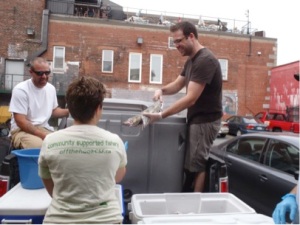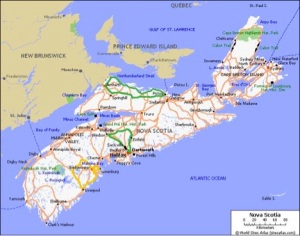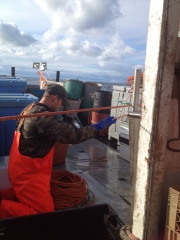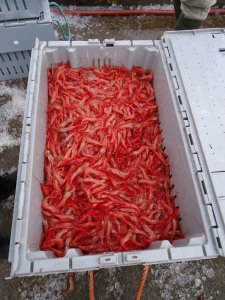Guest contribution by Justin Cantafio.
Moving food around in Nova Scotia is no picnic. Especially when it’s fish.
Our province simply doesn’t have a regional distribution network for seafood. Most distribution networks that do exist in Nova Scotia are geared towards bulk export to commodity scale markets in New England. Meanwhile, our local producers engaging in sustainable practices cannot meet the growing demand for sustainable and traceable food. Small-scale fishermen are stuck when it comes to transporting their products to the regional markets that demand them.
Traceable distribution networks are key to ensuring that small-scale producers receive a fair price for their product. Connecting fishermen with consumers on regional markets allows fishermen—rather than distant markets—to set fair prices that better reflect regional supply, demand, and quality.
If we care about Nova Scotia’s small-scale food producers, then it is clear that we need to build an alternative. By joining forces, fishermen and farmers can combine capacity and supply to grow a regional distribution network that benefits everyone. Focusing on local seafood, let’s explore how an online network based on community, cooperation, and efficiency within the broader local and regional food movement could help solve Nova Scotia’s regional food distribution conundrum.
Fish prices in Nova Scotia are generally set by distant markets in New England and don’t reflect regional supply or demand. Further confounding the issue is that fish prices set in Boston fail to distinguish between different fishing methods. This means that small-scale bottom hook-and-line fishermen are left unable to reach consumers seeking their sustainably caught seafood, and are forced to dump their catch into bulk commodity markets with bottom trawled fish, where prices are dictated by volume.
The local and regional food distribution conundrum is not new. Back in early 2007, the Ecology Action Centre hosted Loaves and Fishes: An Afternoon of Sustainable Solutions, an event which brought members of Nova Scotia’s agricultural, and fisheries communities together to discuss barriers and opportunities for developing the local food movement in the province. Agreeing that distribution was a major obstacle, participants saw a potential solution around building business opportunities to combine products and transportation. They also felt that producers should work cooperatively to coordinate distribution.
Distribution is one of the most significant market barriers for small-scale producers because many simply cannot afford the time or costs required to get their products to market on their own. Many communities where fish is landed or food is grown are geographically isolated and may not be serviced by reliable transportation. The lack of reliable transportation that can accommodate fluctuating products and volumes undermines the building of a regional, traceable food system in Nova Scotia—a province committed, in legislation, to having 20% of its food dollars spent on locally sourced food by 2020.

Off the Hook Community Supported Fishery- an example of traceable small-scale distribution.
However, by working together to coordinate underused and disconnected food distribution, small-scale producers can meet the growing demand for regional, sustainable, and traceable food. Indeed, there are some people getting their product to market. Many producers do distribute on a regular schedule, such as those running community supported agriculture (CSA) or community supported fishery (CSF) programs. Food bank organizations and smaller transportation companies are also on the road. The bottom line is that there are trucks on the road getting food to markets, and many of those trucks have excess capacity in the form of empty space or even empty backhauls. Meanwhile, many small-scale producers are seeking a reliable and affordable means to get their products to market. So how do we work together for the benefit of all?
Could a solution be found in the form of a regional distribution network that focuses on promoting traceable efficient connections? The idea, introduced and incubated at the Refresh Food idea lab held in Wolfville in January of 2014, is to create a network that could serve as a sort of online matchmaking forum to connect producers with distributors. Based around an interactive, real-time mapping system, distributors could charge a fee for the use of extra space in trucks that are already making weekly routes, thus offsetting their fuel costs. Meanwhile producers could secure reliable, predictable, and affordable access to markets that may have been previously unreachable.
An interactive map could allow the network to show existing regional transportation routes in real time. Distributors would post their information to the network, which would then appear on the map as a green “route”. Members could click on existing routes to learn about the distributor, what stops they make, what days they make their rounds, what products the truck is certified to carry, or whether the truck is refrigerated, for example. They could then contact distributors via an internal messaging system to set up transportation rates. When a route became saturated, it would turn to red.

A mock-up of what an interactive food distribution network map could look like (green routes are posted by distributors with excess capacity, and yellow routes are requested/suggested routes).
Importantly, members could also submit route requests. If enough users in a region found themselves requesting the same route, they could potentially pool their resources and work together. A series of suggested routes could also promote enterprising people or transportation companies to create the route. Demonstrating existing demand and capacity patterns, along with confluences of local food products could even spur the development of more sophisticated regional food hubs.
Membership-based, the online network could also serve as an online community whereby users could validate one another. Similar to online networks like Couch Surfing, for example, if a certain distributor has been reliable and punctual, users could speak their praises. Similarly, if distributors are not properly servicing the routes or are often late, users could submit negative comments.
A regional food distribution network could take many forms. But whatever the features, the most important function overall would be to directly connect producers with distributors, thereby forging real relationships through cooperation, and ultimately ensuring that food remains completely traceable throughout the value chain.
Securing access to reliable, affordable distribution that maintains traceability along the value chain is a major concern for small-scale fishermen and farmers in Nova Scotia. A web-based, interactive, real-time network that promotes transportation efficiencies through cooperation could help solve the distribution conundrum. A network would allow fishermen and farmers to reduce costs and get their products to the markets that are increasingly demanding them, which would ultimately bolster Nova Scotia’s local and regional food movement. It would also show both capacity and demand in real time, offering the potential for further cooperation, entrepreneurship, and ultimately- rural economic development. And ensuring traceability will allow consumers to know where their food comes from.
Justin Cantafio is the Sustainable Fisheries Campaigner on the Marine Team at the Ecology Action Centre.



Reblogged this on Adventures in Local Food.
Pingback: Reeling in Big Value from our Small-Scale Fisheries | Small Scales